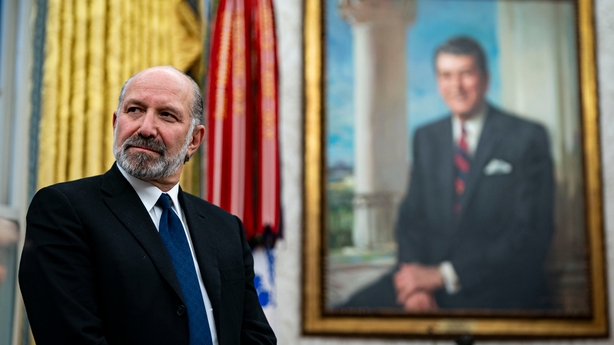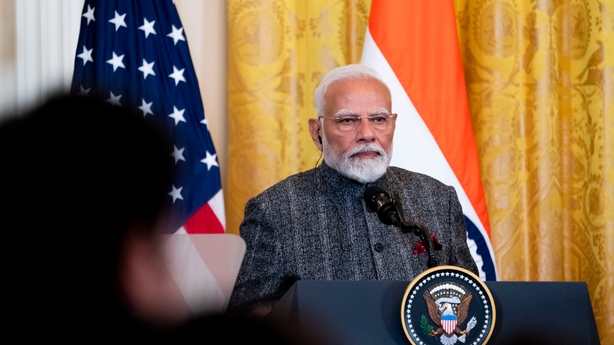US President Donald Trump has tasked his economics team with devising plans for reciprocal tariffs on every country that taxes US imports, raising the risk of a global trade war with American friends and foes.
“On trade, I have decided for purposes of fairness, that I will charge a reciprocal tariff, meaning whatever countries charge the United States of America, we will charge them. No more, no less,” Mr Trump told reporters in the Oval Office.
Mr Trump signed a memo ordering his team to start calculating duties to match those that other countries charge and to counteract non-tariff barriers such as vehicle safety rules that exclude US autos and value-added taxes that increase their cost.
Yesterday’s directive stopped short of imposing fresh tariffs, instead kicking off what could be weeks or months of investigation into the levies imposed on US goods by other trading partners and then devising a response.
Meanwhile the EU has vowed to respond “firmly and immediately” to trade barriers, saying that Mr Trump’s plans were “a step in the wrong direction” that heightened economic uncertainty.
We need your consent to load this comcast-player contentWe use comcast-player to manage extra content that can set cookies on your device and collect data about your activity. Please review their details and accept them to load the content.Manage Preferences
Wall Street is anxious further tariffs may accelerate US inflation, prevent the Federal Reserve from cutting interest rates and slow economic growth. The absence of further trade measures for now, drove global markets higher.
“While global financial markets may be inclined to take some relief from the delay in the immediate imposition of reciprocal tariffs, it is not clear to us whether the delay necessarily reflects a lower likelihood that they will eventually be imposed,” Barclays analysts said in a note.
Mr Trump’s potential targets include the European Union, China, Japan and South Korea.
Read more:
How worried should Ireland be about Trump’s ‘fair’ tariffs plan?
Ireland in the crosshairs of Trump 2.0
Explainer: What are tariffs and how do they work?
Trump unveils reciprocal tariffs, says EU ‘brutal’ on trade
Howard Lutnick, Mr Trump’s pick for commerce secretary, said the administration would address each affected country one by one and said studies on the issue would be completed by 1 April.
That is also the deadline Mr Trump set on his first day in office for Mr Lutnick and other economic advisers to report to him with plans to reduce the chronic trade imbalances that Mr Trump sees as a US subsidy to other countries.

Mr Trump, who campaigned on a pledge to bring down consumer prices, said prices could go up in the short term as a result of the moves. “Tariffs are great,” he said.
A White House official, who spoke to reporters before Mr Trump’s event in the Oval Office, said the administration would study countries with the biggest trade surpluses and highest tariff rates first.
Mr Trump’s tariffs would match the higher duties charged by other countries, he said, and would aim to counteract burdensome regulations, value-added taxes, government subsidies and exchange rate policies that can erect barriers to the flow of US products to foreign markets.”They effectively don’t let us do business. So we’re going to put a number on that that is a fair number. We’re able to accurately determine the cost of these non-monetary trade barriers,” Mr Trump said.
We need your consent to load this rte-player contentWe use rte-player to manage extra content that can set cookies on your device and collect data about your activity. Please review their details and accept them to load the content.Manage Preferences
Open to talks
The broad announcement appeared designed at least in part to trigger talks with other countries. The White House official said Mr Trump would gladly lower tariffs if other countries lowered theirs. The new tariffs would avoid a “one size fits all” approach for more customised levies, he said, though he did not rule out a flat global tariff.
“It’s a relief that the administration isn’t rushing to impose new tariffs, and we welcome the president taking a more nuanced, inter-agency approach,” said Tiffany Smith, vice president for global trade at the National Foreign Trade Council.
“Ideally, this process will result in us working with our trading partners to lower their tariffs and trade barriers as opposed to increasing our own.”
Mr Trump, who took office on 20 January, has already announced tariffs on all steel and aluminum imports beginning on 12 March, imposed 10% tariffs on goods from China, and put a 30-day hold on planned tariffs on goods from neighbouring Canada and Mexico.

Mr Trump said he was also looking at separate tariffs on cars, semi-conductors and pharmaceuticals. Yesterday he said car tariffs would be coming soon.
“This is beyond negotiation. It’s to be taken very seriously,” said Josh Lipsky, director of the Atlantic Council’s GeoEconomics Center and a former adviser to the International Monetary Fund who also served in the Obama administration.
“I do think every country has been put on notice. And if you were going to implement reciprocal tariffs on the scale he’s talking about, this is actually how you would go about it,” he said.
Indian Prime Minister Narendra Modi, who met with Mr Trump in Washington yesterday, oversees a government that imposes the highest tariffs on US exports of any major US trading partner.
Mr Trump said Mr Modi offered to talk about easing tariffs, buying more US oil, gas and combat aircraft, and potential concessions. The leaders agreed to work towards a deal to resolve the trade concerns.
Such a deal could be done within the next seven months, Indian Foreign Secretary Vikram Misri said after the meeting. A senior Trump administration official said a deal could be reached as soon as this year.
“We are being reciprocal with India,” Mr Trump told a news conference. “Whatever India charges, we charge them.”




